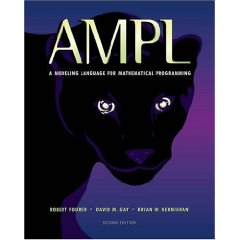Related Research Articles

Mathematical optimization or mathematical programming is the selection of a best element, with regard to some criterion, from some set of available alternatives. It is generally divided into two subfields: discrete optimization and continuous optimization. Optimization problems of sorts arise in all quantitative disciplines from computer science and engineering to operations research and economics, and the development of solution methods has been of interest in mathematics for centuries.
In mathematics, nonlinear programming (NLP) is the process of solving an optimization problem where some of the constraints or the objective function are nonlinear. An optimization problem is one of calculation of the extrema of an objective function over a set of unknown real variables and conditional to the satisfaction of a system of equalities and inequalities, collectively termed constraints. It is the sub-field of mathematical optimization that deals with problems that are not linear.

AMPL is an algebraic modeling language to describe and solve high-complexity problems for large-scale mathematical computing . It was developed by Robert Fourer, David Gay, and Brian Kernighan at Bell Laboratories. AMPL supports dozens of solvers, both open source and commercial software, including CBC, CPLEX, FortMP, MINOS, IPOPT, SNOPT, KNITRO, and LGO. Problems are passed to solvers as nl files. AMPL is used by more than 100 corporate clients, and by government agencies and academic institutions.
IBM ILOG CPLEX Optimization Studio is an optimization software package. In 2004, the work on CPLEX earned the first INFORMS Impact Prize.
MINTO is an integer programming solver which uses branch and bound algorithm.
Branch and cut is a method of combinatorial optimization for solving integer linear programs (ILPs), that is, linear programming (LP) problems where some or all the unknowns are restricted to integer values. Branch and cut involves running a branch and bound algorithm and using cutting planes to tighten the linear programming relaxations. Note that if cuts are only used to tighten the initial LP relaxation, the algorithm is called cut and branch.

Computational Infrastructure for Operations Research (COIN-OR), is a project that aims to "create for mathematical software what the open literature is for mathematical theory." The open literature provides the operations research (OR) community with a peer-review process and an archive. Papers in operations research journals on mathematical theory often contain supporting numerical results from computational studies. The software implementations, models, and data used to produce the numerical results are typically not published. The status quo impeded researchers needing to reproduce computational results, make fair comparisons, and extend the state of the art.
The TOMLAB Optimization Environment is a modeling platform for solving applied optimization problems in MATLAB.
nl is a file format for presenting and archiving mathematical programming problems. Initially, this format has been invented for connecting solvers to AMPL. It has also been adopted by other systems such as COIN-OR, FortSP, and Coopr.

The Zuse Institute Berlin is a research institute for applied mathematics and computer science on the campus of Freie Universität Berlin in Dahlem, Berlin, Germany.
BARON is a computational system for solving non-convex optimization problems to global optimality. Purely continuous, purely integer, and mixed-integer nonlinear problems can be solved by the solver. Linear programming (LP), nonlinear programming (NLP), mixed integer programming (MIP), and mixed integer nonlinear programming (MINLP) are supported. In a comparison of different solvers, BARON solved the most benchmark problems and required the least amount of time per problem.
MOSEK is a software package for the solution of linear, mixed-integer linear, quadratic, mixed-integer quadratic, quadratically constraint, conic and convex nonlinear mathematical optimization problems. The applicability of the solver varies widely and is commonly used for solving problems in areas such as engineering, finance and computer science.
APOPT is a software package for solving large-scale optimization problems of any of these forms:
MINOS is a Fortran software package for solving linear and nonlinear mathematical optimization problems. MINOS may be used for linear programming, quadratic programming, and more general objective functions and constraints, and for finding a feasible point for a set of linear or nonlinear equalities and inequalities.
Deterministic global optimization is a branch of numerical optimization which focuses on finding the global solutions of an optimization problem whilst providing theoretical guarantees that the reported solution is indeed the global one, within some predefined tolerance. The term "deterministic global optimization" typically refers to complete or rigorous optimization methods. Rigorous methods converge to the global optimum in finite time. Deterministic global optimization methods are typically used when locating the global solution is a necessity, when it is extremely difficult to find a feasible solution, or simply when the user desires to locate the best possible solution to a problem.
Artelys Knitro is a commercial software package for solving large scale nonlinear mathematical optimization problems.
Algebraic modeling languages like AIMMS, AMPL, GAMS, MPL and others have been developed to facilitate the description of a problem in mathematical terms and to link the abstract formulation with data-management systems on the one hand and appropriate algorithms for solution on the other. Robust algorithms and modeling language interfaces have been developed for a large variety of mathematical programming problems such as linear programs (LPs), nonlinear programs (NPs), Mixed Integer Programs (MIPs), mixed complementarity programs (MCPs) and others. Researchers are constantly updating the types of problems and algorithms that they wish to use to model in specific domain applications.
ANTIGONE, is a deterministic global optimization solver for general Mixed-Integer Nonlinear Programs (MINLP).
Octeract Engine is a proprietary massively parallel deterministic global optimization solver for general Mixed-Integer Nonlinear Programs (MINLP). It uses MPI as a means of accelerating solution times. It is notable for its parallelism and for ranking ahead of all other global MINLP solvers in the Mittelmann MINLP benchmark. As of January 2023, it is also the first solver to ever solve 99% of problems in this benchmark.
References
- ↑ P. Belotti, C. Kirches, S. Leyffer, J. Linderoth, J. Luedtke and A. Mahajan (2013). Mixed-integer nonlinear optimization. Acta Numerica, 22, pp 1-131. doi:10.1017/S0962492913000032. http://journals.cambridge.org/abstract_S0962492913000032
- ↑ M. Tawarmalani, N.V. Sahinidis. Convexification and global optimization in continuous and mixed-integer nonlinear programming: theory, algorithms, software, and applications. Vol. 65. Springer Science & Business Media, 2002.
- ↑ P. Belotti, J. Lee, L. Liberti, F. Margot, & A. Wächter (2009), Branching and bounds tightening techniques for non-convex MINLP. Optimization Methods & Software, 24(4-5), 597-634.